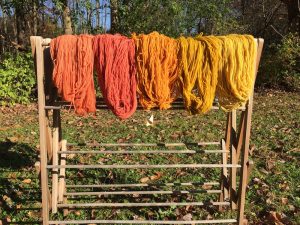On October 21st, 2017 I presented a workshop on growing and using dye plants with kids at the Inside-Outside Conference in Keene, NH. The conference was a collaboration of several local organizations, including Antioch University New England, the Monadnock Region Placed-Based Education Committee, the Harris Center for Conservation Education, the Caterpillar Lab, Symonds Elementary School (where the conference was held), and the Keene School District. The theme was “Promising Practices in Nature- and Place-Based Elementary Education.” You can view the brochure by clicking this link Inside Outside 091817.
The audience was K-6 educators from a variety of educational settings. I don’t mention this very often on this blog, but I actually am a teacher! I co-teach in a combined first and second grade at the Common School in Amherst, MA, where I’ve been working since 2004. Most of the time, I am in the classroom doing all the usual academic things: reading, writing, word study, math, science, social studies, arts and crafts. I do fiber and dye projects with kids when I can, and the rest of the time I squeeze it in on weekends and vacations.
Back to the conference: My time-frame was 2:15-3:45 in the afternoon. This is a normal amount of time for most workshops at a day-long conference like this, even hands-on workshops. The only trouble is that all the steps in natural dyeing take a long time. If you want to make a dye bath with fresh, frozen, or dried plant material it takes at least 45 minutes to an hour, and then in an ideal world you let that sit overnight. Dyeing the skeins of yarn takes the same length of time. I always let the skeins or fiber sit overnight if I can, and I let them dry before I rinse them. Also, you have to mordant the fiber ahead of time. You cannot possibly fit it all in to an hour and a half. Nevertheless, I had committed to teach this thing. Making color with plants is so magical and so do-able that I am always happy to encourage people to try it.
So, I was excited about it, but also anxious. Basically I was counting on the fact that this would be a group of folks who are interested in process over product, and would want to see and participate in how the dye baths are made. Hopefully people felt satisfied with what we were able to do in that time:
- make the dye baths (measure/weigh the materials, add pH amendments, test pH, set the baths to heat up)
- talk about some considerations for setting up a dye plant garden or incorporating dye plants into an existing garden
- look at some examples of projects I’ve done with kids
- browse some of my favorite reference books
- strain the dyebaths and put in the yarn
We were literally putting in the last skein of yarn at 3:45!
True to its name, we were outside for part of the workshop, and inside for part of it. When I set up in the morning, the outdoor space was shady and pleasant. A helpful custodian helped me run two long extension cords out of two windows, down to the ground on the playground below. There, I set up two portable electric burners. I set up everything we would need for dyeing outdoors, I set up books, hand-outs, and project samples in the classroom, and then headed off to enjoy the rest of the conference.
By 2:15, the sun had come around to our side of the building and it was blazingly hot. You wouldn’t have anticipated a blazingly hot day in late October, perhaps, but such it was. I think it was about 80 degrees. I had a great group of participants, about 20 folks, who obligingly tolerated the blazing heat for a few minutes while we got started. But it was really uncomfortable! I was feeling bad about it, but also feeling kind of stuck and unsure of what to do. Then, someone pointed out that it was shady just around the corner of the building. Yay! We moved things around the corner, and Ellen Doris (a former colleague at the Common School and my contact for the conference) brought an extra extension cord. We all breathed a sigh of relief in the small patch of shade behind a wall, and proceeded to set up the dye baths.
Here are the skeins drying afterwards on a rack at home:
We used four dyes for this workshop: madder, weld, orange cosmos, and marigolds. In my next post I will go into all the details of exactly how we obtained these colors!


